Coptic protestors at Maspero suffered two separate attacks on May 14, attacks which included Salafi Muslims along with common ‘thugs’. This report updates a previous text written about the Maspero attack, which was crafted from interviews with leaders the day of May 14, supplemented with media reports the next morning and phone calls to Mina Magdy, the political affairs coordinator for the Maspero Youth Union (MYU). According to witnesses interviewed May 16, a number of the details related in the news have been incorrect, if not outright misleading. This report is unable to corroborate claims independently. Efforts to speak with local army and police personnel on the scene were politely declined, as would be expected, in deference to announcements made by the Supreme Council of the Armed Forces. To my knowledge, they have not commented directly on this event.
Security Measures
Testimony is taken primarily from Emad Farag. Farag is part of the committee for order, tasked with securing the northern entrance to the sit-in near the Foreign Ministry. In my earlier report I wondered why Coptic security measures were so tight, while a simple rope separated the sit-in area from the major thoroughfare running north-south along the Nile River. Farag explained the sit-in had previously cut off this road, but it was reopened through negotiations with Prime Minister Essam Sharaf. In exchange for agreement to retry arrested members of MYU, who were apprehended during the first sit-in, General Coordinator Rami Kamel consented to pull back the protest area.

Upon arriving at Maspero on the morning of the 16th, however, I was surprised to find no Coptic security measures at all. Automobile traffic had stopped as dozens of riot police, army personnel, and military vehicles lined the road. Yet pedestrians, including myself, simply walked right through their lines, checked neither for ID nor weapons. Farag explained the army had assumed responsibility for safety after the attacks, and instructed the Copts to desist.
Farag then proceeded to relate the story of the evening attack. Around midnight, while he was stationed at his post, a group of ‘thugs’ began to gather under the May 15th bridge, and began harassing and beating individual Coptic protestors either leaving or joining the sit-in. Shortly thereafter, another group came from over the bridge, and began firing upon the Copts, though from a very far distance of about 1000 meters. When meeting up together, they began to advance toward the sit-in, carrying knives, swords, clubs, and stones, in addition to guns.
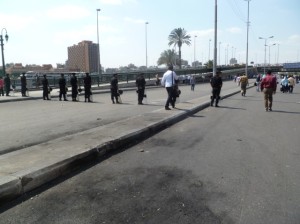
Their approach took the attention of the protestors, but Farag instructed his colleagues in the committee to lock arms in front of the already constructed barbed wire, so as to prevent Copts from running out to meet them. Farag then phoned the captain of the police, who told him his men were ill equipped to meet armed ‘thugs’. They were stationed a few hundred meters to the north of the sit-in, blocking off a side road to the area. Their presence, though, was minimal, and outfitted only with riot shields and batons. The captain told him, however, he would phone the army to bring its weapons truck.
Farag then went personally to speak to an army officer who was stationed with his men at the Radio and TV building at the site of the sit-in. The officer refused to get involved, stating this was the responsibility of the police.
By this time some of the Copts had broken through the human chain and jumped through the barbed wire barricade. They wished to hold the ‘thugs’ far away from the sit-in, since several women were also participating there. Farag called the police captain again, who now responded that they could not get involved because they could not know who was who in the skirmish. Frustrated, Farag returned to his post and told the other assembled Copts to join in the defense, which he himself did as well.
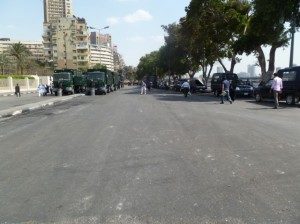
Running out to meet the ‘thugs’, Copts broke off tree branches and wooden planks from sidewalk benches. Media reports stated they also broke up the sidewalk so as to obtain concrete to hurl at their assailers. Farag did not think so, but a few meters from the barbed wire was an area, perhaps one meter in diameter, that was pulled up. Perhaps Copts did so, Farag contemplated, but on the whole he believed they simply threw back the projectiles tossed at them. In any case, this was the only evidence of sidewalk destruction, not fitting with the impression of chaos described in some reports.
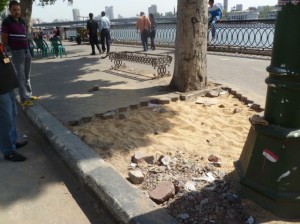
The two groups met about halfway between the sit-in area and the off-ramp of the May 15 bridge. There were immediate but brief clashes, after which Copts drove the ‘thugs’ back up the off-ramp where they took refuge on higher ground. From this point onward a buffer zone developed between the two sides, with rock throwing between them but also gunfire coming from the original attackers.
Farag confirmed media reports stating the Copts apprehended one of the ‘thugs’, and turned him over to the army. He was unable to confirm a report that stated the ‘thug’ possessed an ID card linking him to the NDP party of Mubarak. Yet Fadi Philip, foreign media spokesman for the MYU, stated he admitted to being paid 500 LE, the equivalent of slightly less than $100 US, by a sheikh in order to participate in the attacks.
Farag added incidentally that throughout the sit-in the committee for order turned over to the army a number of entrants upon whom were found weapons after being searched. He stated the army confiscated the weapons, but then sent the people on their way.
Given that he was a participant in the defense, Farag did not know exactly how much time had passed until the authorities arrived. He estimated that about an hour after the clash began, a police tear gas truck came from behind the Coptic position and launched its canisters which landed on the Coptic side of the standoff. The tear gas sent all parties scattering; Copts ran back to the sit-in area while the ‘thugs’ ran off into the distance. Farag states neither the police nor the army pursued the assailants. Media reports, however, claim that fifty ‘thugs’ were arrested for their role in attacking Copts during the sit-in. It is possible these were later apprehended.

Farag then walked with me to the southern entrance of the sit-in area, to describe the attack which happened earlier. Though he was not present at the beginning, he ran to the scene to investigate when commotion occurred. Around 8pm a group of 100-200 ‘thugs’ descended the on-ramp of the October 6th bridge, and a similar story unfolded. Copts ran out to meet them, suffered injury from gunfire and other weapons, but drove them away after only ten minutes. In my earlier survey of the news, I was not aware of this attack. Farag stated that men in the appearance of Salafis were among the armed in this group as well. Salafi presence had been denied in earlier media reports.

Media Manipulations
Along the way he refuted two matters that have been reported in the media. First, he directed attention to the Foreign Ministry and the Radio and TV building. It was claimed that Copts had attacked these building before the altercation, but neither showed signs of damage. It is possible minor damage may have been repaired, as a full day had passed between the altercation and my visit.
The second matter represented what Farag claimed was a propaganda falsehood. On the first floor balcony of the Radio and TV building was erected a video camera pointing to the main stage, but on a swivel pivot. Farag stated the camera was pointed toward empty ground to the side of the stage, and showed this footage on state TV, claiming the sit-in was over.

Statements concerning the end of the sit-in may well have been believed coming on the heels of Pope Shenouda’s message on TV, apparently urging its abandonment. The pope declared the matter had moved beyond the level of expression, due to infiltration that was ruining the reputation of the protestors, as well as of Egypt. He feared for their safety after the attacks, and said they would be ‘the losers’ if they continued. Furthermore, he stated, the patience of the nation’s leaders was growing thin.
Fr. Mattias Nasr Manqarius, priest of the Virgin Mary Church in Ezbet al-Nakhl, Cairo, is the official spokesman for the MYU, and one of two priests committed to the sit-in. He stated the pope’s words were not meant as a directive for the protestors to leave; in fact, he stated he had visited the pope shortly before his announcement, and was given only encouragement for their ‘normal and righteous’ demands. The next day, however, Bishop Musa, bishop of youth, confirmed the validity of the pope’s encouragement to leave Maspero.
Media manipulations, however, are claimed by the MYU. Before the pope spoke on television, a report emerged from Bishop Musa urging the youth to give up the sit-in. Asked about their refusal to heed his words, Rami Kamel stated the bishop’s words were not conveyed correctly. He knew this from video messages afterwards from the bishop in which he denied asking them to leave. Instead, the bishop offered his blessing. Irresponsibility of the media, claims Philip, was one reason why the MYU chose to demonstrate at the Radio and TV building at Maspero in the first place.
Medical Clinic
Injured Copts from the two attacks were treated at a makeshift clinic. A total of twenty-four doctors, nurses, and pharmacists have set up shifts in order to provide medical care. All medicines have been donated, and George Sidky Eskander, who has taken a vacation from his pharmaceutical company in order to join the sit-in, states supplies and equipment have always arrived at just the right moment, as if from God.

Three of the twenty-four medical team are Muslims, one of which even keeps to the Salafi trend, but rejects the behavior of those practicing violence. Another Muslim is Mustafa Ibrahim. Though possessing no medical education he has been trained in field-based first aid, and has volunteered previously in Tahrir Square and in Libya. He states he is willing to die here with his brothers the Copts. His assistant, the other Muslim Ahmed al-Masry, is a graphic design student at Ain Shams University, but learned medical care from his father, a surgeon. He is disturbed how religious groups are tearing the nation apart, after the experiences of Muslims and Christians together at Tahrir Square. As a revolutionary there, he was shot in the arm by police on January 25, the first day of protests.
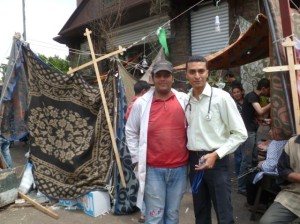
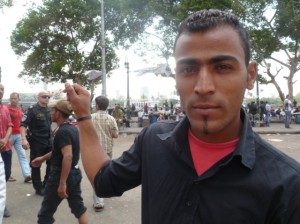
Eskander stated that many of the injured refused to be transported to hospitals, out of fear they would be arrested there. Instead, during the attacks of May 14 the clinic tent grew three times in size, treating open wounds and bruises as best they could. Many of the serious cases, such as one skull fracture, were rushed to local hospitals.
Legal Services
Karam Ghubriyal is a Coptic lawyer providing volunteer legal services and documentation for the MYU. He stated that fifty-six people were arrested from two hospitals, and only eight of these were Muslims. It is not known if this number corresponds to the totals announced of those involved in the attack, or has simply been unreported in the media. These arrested were taken from the Coptic Hospital on Ramsis Street and the Police Hospital in the Aguza neighborhood. They were charged with ‘thuggery’, and detained first in a military holding facility, before being transferred to a public jail.
Ghubriyal, working with a team of lawyers including several Muslims, was able to secure the release of thirty-two arrested Copts. Due to the late hour running into the designated curfew of 2am, Ghubriyal made sure those returning to Minya in Upper Egypt did not try to return home and perhaps be rearrested. Instead, the five went back to Maspero and spent the night at the sit-in. He is currently working with his team to secure the release of the remaining sixteen Copts in custody.
Area Management
As the day progressed Maspero appeared more and more chaotic, as pedestrians on foot traversed the area on their way north or south. The army permitted street vendors to enter the area as well, setting up booths for tea or snacks. More and more Copts also arrived simply to join in the demonstration. It was a working day, and thus numbers did not resemble the weekend totals of several thousands, but it was clear many Copts continued to support the effort, despite the message from Pope Shenouda.
Rolla Subhi is a twenty-two year old Coptic woman heading up the committee for order. She supervises the subcommittees for checkpoints, as mentioned earlier with Farag, the speaking state, food, drink, and cleanup, and a very important committee – given the increasing commotion – called ‘rangers’.
Ramon Nadir and Claire Makram are two of the approximately fifty rangers, ten of whom are women. Their responsibility is to roam the area and look for signs of trouble. They communicate with the Egyptian police and army, and were able later in the day to re-setup the separate Coptic checkpoints to ensure no weapons entered the area. They inquire about the hunger, thirst, or fatigue of key volunteers. Perhaps their most important responsibility is simply to check in on crowds. Whenever a group begins to assemble of more than three or four, and certainly if voices are raised, the nearest ranger investigates to see that everything is ok. Rangers make certain disputes are resolved quietly, before escalation. It is impossible to control every Copt who comes to protest, Subhi states; fears exist that less educated or more traditional Copts might respond to an insult given, becoming easily provoked. The ranger team, however, has kept problems to a minimum so far.
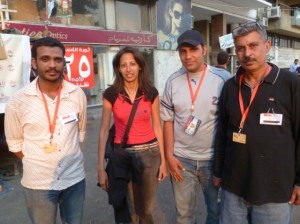
Conclusion
In his first live television appearance, General Tantawi of the Supreme Council for the Armed Forces addressed the graduating class of the police academy. He stated the most urgent needs of Egypt rest in its economic and security stabilization. He promised he would not allow any forces to divide the national unity of Egyptians along religious lines, mentioning specifically that sit-ins harm the economy and provide opportunity for ‘thugs’ to wreak havoc toward their self-serving goals.
Many at Maspero believe the actions of the army and police, in this and other sectarian instances, to indicate they are against not only the Coptic sit-in, but biased against Copts in general. Coupled with an understanding that Pope Shenouda has declared them to be ‘the losers’ if they continue, the protestors believe more violence will be directed their way, and perhaps they will be evicted by the army. For now, their protest continues, but Fr. Mattias does not paint a pessimistic picture. ‘Yes’, he states, ‘some of our demands have been met. Sixteen closed churches have been promised to be reopened. We believe the authorities when they say they will open them. But we will stay here until it actually happens, so that lower level officials receive pressure from above to make it happen.’
It is difficult to say if the Copts, and several Muslims, at Maspero are correct in their actions. They press on contrary to the leanings, if not will, of both their civil and religious authorities. Yet they are people of conviction, courage, and organization, fighting for the rights of all Egyptians, not just Copts. Their appearance, either if manipulated through the media, or if truly in essence, is of a separatist action. Are they uniting Egyptians, or dividing them? If dividing, is it in positive effort to bring awareness to those in the dark?
Philip sees their struggle as akin to the civil rights movement in the United States. It is not only that laws are bad, but that good laws are not enforced. ‘It is not just for ourselves that we demonstrate,’ he says. ‘If Coptic rights are not respected, then perhaps next to fall will be the rights of Muslims of different persuasion.’
It is too difficult to judge, and furthermore it is not my place. Yet may prayer be asked for wisdom on their behalf, patience for those who grow weary of their voice, and forgiveness for those who violently attack them. May all find place to give blessing to the other, no matter how stridently they wrestle politically.